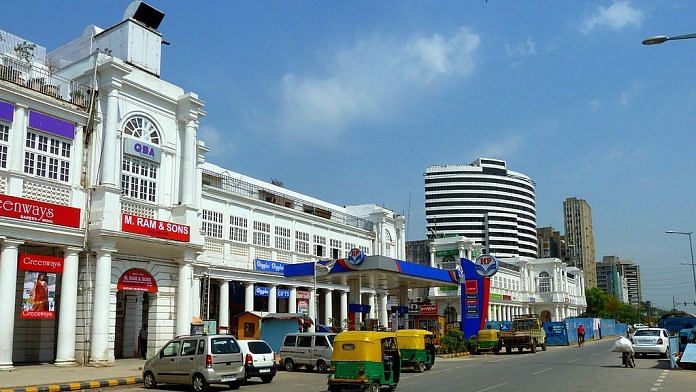New Delhi: As the air quality in the national capital turned “poor” last week, the Delhi government decided to install a smog tower at Connaught Place, one of the main business centres in the city, to fight air pollution.
A smog tower is a structure designed as a large-scale air purifier to reduce air pollution.
Chief Minister Arvind Kejriwal made the announcement of the smog tower last Friday. It is expected to cost Rs 20 crore.
Since the announcement, the national capital recorded the season’s worst air quality index (AQI) on 13 October, which falls in the very poor category.
The Connaught Place smog tower will be in addition to another being installed in Anand Vihar by the Central government.
Environmental experts, however, have constantly argued that anti-smog towers are an ineffective means to control pollution. They have raised concerns over the feasibility of smog towers, claiming that there are no studies to assess the impact of this technology on the ambient air quality.
“From a public health perspective, smog towers should be thought of as the last resort,” Ravindra Khaiwal, Professor of Environment Health at PGIMER Chandigarh, told ThePrint.
He said the focus of pollution prevention measures should be at the source. People working in polluting industries are at an increased health risk due to pollutants. But smog towers target a population that is exposed at the very end, he said.
The government, on its part, insists that the towers are just a pilot project.
“As the CM announced, this is a pilot project and if we don’t see the desired result, we will not necessarily expand it,” a senior Delhi government official said. “Feedback will be taken from all stakeholders so we shouldn’t jump to conclusions yet.”
ThePrint contacted Environment Minister Gopal Rai through texts and calls but received no response. This report will be updated if he responds.
Also read: Long queues, social distancing, new rules — Delhi’s Akshardham temple reopens after 6 months
Not the first smog tower in Delhi
In November 2019, an expert panel estimated that Delhi will need a total of 213 anti-smog towers to battle the pollution crisis.
On 3 January, Delhi’s first smog tower came up at the Lajpat Nagar Central Market. It was the result of efforts by Gautam Gambhir, the former cricketer who is the BJP MP from East Delhi.
Smaller than the one being proposed at Connaught Place, the smog tower was built at a cost of Rs 7 lakh, and has been installed 24 feet above road level. If reports are to be believed, it can purify air up to a distance of up to 750 metres, and clean 2.5 to 6 lakh cubic meter of air daily.
The purifier’s exhaust fans are expected to remove up to 80 per cent of the PM 2.5 and PM 10 pollutants in the air in the vicinity.
Science behind smog towers
The idea that smog towers could help clean polluted air gained significant momentum in several countries in recent years. In 2018, China had set up the world’s largest air purification tower in the city of Xi’an. According to reports, the 100-metre-high tower was able to make significant improvements to Xi’an’s air quality.
The towers are designed to suck in polluted air, which passes through multiple layers of filters before being released back into the environment.
The technology devised for the two smog towers coming up in Anand Vihar and Connaught Place is different from that used in China, according to a Delhi government statement.
“In China, the smog-tower sucks the polluted air from down below and releases clean air from above. Our smog tower will suck the polluted air from above, and release the clean air from the bottom,” the statement reads.
The towers can purify air around a limited radius.
“The process of purifying air makes sense when we are indoors. But in outdoor situations, the air is so dynamic — wind is flowing in from all directions — and the volume of air is too large,” said Anumita Roychowdhury, executive director at the Centre for Science and Environment (CSE).
She said the air coming out of the outlet of the air purifier will definitely be cleaner than what goes in, but this is unlikely to have any impact on the ambient air.
The government has also pointed out that Delhi’s air pollution problem is not an isolated phenomenon, but rather a common problem faced by the airshed that includes parts of Rajasthan, Haryana, Punjab and Uttar Pradesh.
Pollutants from each of these states play a part in the pollution in north India, Rowchowdhury said, adding that air purification towers are unlikely to help combat pollution of such scale.
The money being used to put these towers could be used to provide cleaner fuels to small scale industries — which would cut the pollution at the source, Rowchodhury added. “Such measures will also reduce people’s exposure to pollution,” she said.
In fact, last year, a group of environmentalists urged it not to direct the Centre or states to spend public money on “expensive” and “inefficient” smog towers as they will only benefit the manufacturers.
“Please don’t direct any governments, local, state or central to spend public money to buy expensive smog towers. These are ineffective in bringing down PM2.5 levels and may even add to pollution when the dirty filters are disposed of in landfills and burnt,” the group said.
“India’s leading air pollution scientists and researchers unanimously say that outdoor air purifiers are inefficient to the point of being useless,” Jyoti Pande Lavakare, co-founder of Care for Air India, a nonprofit advocacy group, wrote.
Also read: How cycling has become India’s greatest Covid lockdown love affair



